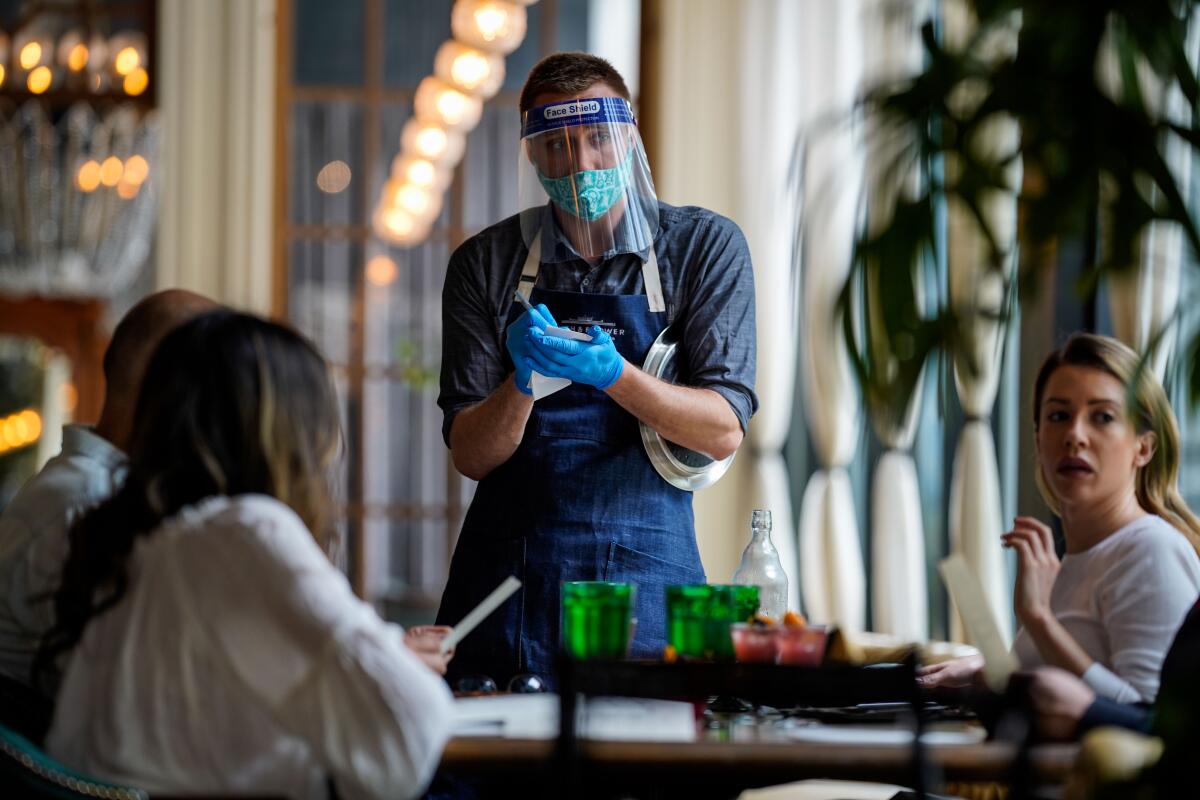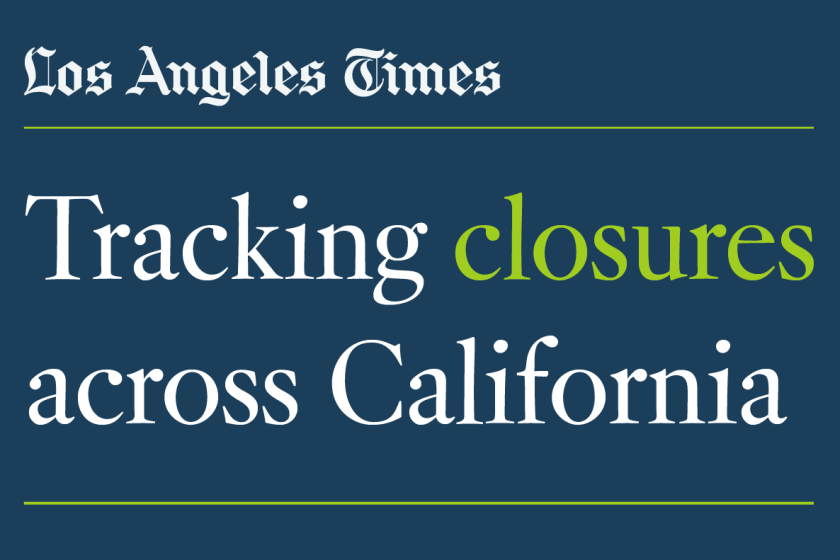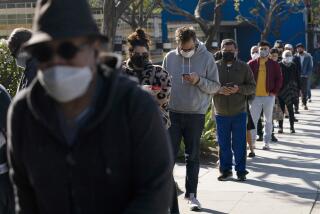Bars, indoor dining could remain closed for the foreseeable future amid coronavirus surge

- Share via
SAN FRANCISCO — With coronavirus cases surging in California, there are growing doubts that indoor dining and bar service will reopen anytime soon as health officials zero in on how to slow the spread of COVID-19.
Public health officials say indoor dining and drinking pose more significant public health risks than other retail activities, even with social distancing. Patrons must take off their masks to eat and drink, they often are engaged in conversation, and they breathe in indoor air that may be contaminated by the virus and circulated by air conditioning — all of which can spread COVID-19.
Restaurants are the lifeblood of the retail economy in many cities, and the reopening of dine-in service followed by the abrupt closures have left the already struggling bar and restaurant industry devastated.
But experts and local, state and federal officials have said in recent days that it’s simply too risky for bars and indoor dining rooms to continue operating as the coronavirus surges. Allowing them to operate as cases spike threatens the wider reopening of the economy and the resumption of school in the fall, they said, and also threatens to overwhelm hospitals.
“That pretty much means that we are not going to have indoor dining anytime soon,” said Dr. Sara Cody, health officer for Santa Clara County, Northern California’s most populous county.
Dr. Anthony Fauci, the U.S. government’s top infectious disease expert, said this week that closing bars is important to curbing the spread of the virus, because they’re often crowded with people not wearing masks.
“When you are indoor ... in the crowded situation in the bar, that’s a perfect setup for the spread of infection,” Fauci said in an online conversation hosted by Sen. Doug Jones (D-Ala.). “Fundamental things like masking, distancing, washing hands, closing bars: If you do that, I think it will be a giant step towards interfering with the spread in your community.”
There are now at least 27 counties in California that have been subject this month to Gov. Gavin Newsom’s instruction to order bars and indoor dining rooms at restaurants closed for at least three weeks or to keep them shut if they have not been allowed to reopen. Together, more than 32.9 million Californians live in these counties, which make up 84% of the state’s population.
San Francisco is not one of those counties on the state’s monitoring list, but this week decided on its own to call off next week’s planned reopening of outdoor bars and indoor dining rooms at restaurants.
And farther south, in Silicon Valley, Santa Clara County officials said bars and indoor dining won’t be allowed to reopen for the foreseeable future — regardless of whether state officials permit the county to make that decision.
“We have no choice. We are living in COVID,” San Francisco Mayor London Breed said this week. “We need these numbers to go down.”
The reversal is wrenching for owners, who suffered massive losses during the stay-at-home order and were bracing for even more losses because the social distancing rules limited capacity when they were allowed to reopen.
“We’re getting destroyed,” said Chad Cline, co-owner of the Waterfront Bar & Grill in San Diego’s Little Italy. “In the past month we just wanted to not sink as fast, and now they’ve given us lead weight belts, so we’re in this constant state of sinking. I get there are these experts making these recommendations, but my issue is if a certain industry bears the burden for society’s safety, society should be helping with that burden financially.”
When restaurants were allowed to reopen for indoor dine-in service, officials in Los Angeles County found that many were not following safety rules. Inspectors found that on June 27 and 28, 49% of bars and 33% of restaurants were not adhering to physical distancing protocols indoors, while 54% of bars and 44% of restaurants were not enforcing mask and face shield requirements.
The L.A. County Board of Supervisors this week voted to allow health officials to impose fines or immediately revoke the permits of restaurants not complying with COVID-19 health orders.
Southern California has been hit harder by the surge in coronavirus cases than the San Francisco Bay Area.
San Francisco and Santa Clara County have among the fewest coronavirus cases per 100,000 residents of largely populated California counties over the past two weeks; San Francisco has reported 92 cases per 100,000 residents, and Santa Clara County, 91 cases per 100,000 residents.
By contrast, L.A. County has reported 319 cases per 100,000 residents; Orange County, 258 cases per 100,000 residents; and San Diego County, 190 cases per 100,000 residents over the past two weeks, according to the Los Angeles Times’ California coronavirus tracker.
Yet even in the Bay Area, which is still generally faring better than Southern California, officials are sounding the alarm. San Francisco is now in what officials there call a red zone for new cases, reporting more than triple the number of daily diagnosed cases per 100,000 residents than its goal.
And they’re warning that any time it seems as if officials have figured out how to control the coronavirus, the virus seems to find a way to spread once people start getting complacent.
“This virus has proven time and again, in communities around the country and around the world, that it will come back with a vengeance if you let your guard down,” said Cody, the health officer in Santa Clara County.
Experts and health officials across the nation are increasingly zeroing in on bars and indoor restaurants as problem spots. New York City called off its resumption of indoor dining. Miami-Dade County in Florida this week issued an emergency order closing indoor dining service.
“It has become clear in watching the pandemic ... that indoor spaces and close contact put you at particular risk: there’s a higher rate of transmission,” said Dr. Kirsten Bibbins-Domingo, chair of UC San Francisco’s Department of Epidemiology and Biostatistics.
At restaurants, people aren’t wearing masks because they’re eating, and “that means indoor dining is a particularly high-risk activity,” she said. Bars are even higher risk because there’s lots of close contact, it’s crowded, and people are often yelling over the noise.
To contain the spread of COVID-19, parks, restaurants and stores are slowly reopening.
We already know that people forcefully expelling their breath, as when talking loudly or singing, places others at risk for contracting the virus, she said.
It’s also important to recognize the risks bars and indoor restaurants pose to bartenders, waiters and other workers, she added. “For me, personally, I will patronize my local restaurants by ordering takeout,” Bibbins-Domingo said.
Other businesses in Santa Clara County have received the green light to reopen next week under some basic principles: outdoors are safer than indoors; more physical distance is safer; fewer and briefer contacts are safer; and face coverings should be worn consistently.
Santa Clara County will also not allow other venues to reopen in which the nature of the activity does not lend itself to protective measures like wearing masks, staying outside or keeping away from other people.
These venues include indoor swimming pools and saunas, heated exercise rooms, smoking lounges, nightclubs, theaters, stadiums, arenas, theme parks, indoor playgrounds and amusement centers like bounce centers, ball pits and venues that host laser tag.
But businesses that will be allowed to resume next week include hair salons, nail salons, massage parlors and gyms.
“We’re at an inflection point, we’re at a point in this pandemic when it’s crystal clear that COVID-19 will be with us for a long time,” Cody said. “And so we need to adapt to a new way of living that keeps us all safe.”
Cody warned that it will be hard for California to bring the coronavirus back down to controllable levels. “And especially in Southern California, what we’re seeing reflects an exponential growth in transmission that will be extremely difficult to control, and bring back under control,” Cody said.
Southern California officials had chosen to reopen local economies on a much faster pace than the Bay Area and have recently been forced to backpedal. L.A. County, for instance, reopened restaurants for in-person dining on May 29 and allowed bars to reopen on June 19; Santa Clara County never allowed those settings to reopen. L.A. County’s bars were ordered shut on June 28, and indoor dining rooms, on July 1.
The latest maps and charts on the spread of COVID-19 in Los Angeles County, including cases, deaths, closures and restrictions.
Bibbins-Domingo, the UC San Francisco physician and epidemiologist, said California had been a model state for ordering a stay-at-home order earlier than any other state. But it’s now clear that reopening is far more difficult, and Californians are now feeling the consequences of being more complacent in the state’s reopening than New York.
We’re also learning much more about the virus, Bibbins-Domingo said, with many scientists pushing the World Health Organization to recognize that it’s likely the virus stays around in the air in indoor environments where there’s little circulation.
And it was only on June 18 that Newsom issued a statewide order to wear masks in public, more than a month after the state began allowing counties to decide on reopening businesses.
“If I had to point to one thing, I would have loved us to [have] a clear awareness that we were not going to be able to open up without masks,” Bibbins-Domingo said. “It has been a learning experience to understand that indoors is a much riskier environment than outdoors.”
Lin reported from San Francisco, and Lee and Greene from Southern California. Times staff writer Garrett Snyder as well as Lori Weisberg and Pam Kragen of the San Diego Union-Tribune contributed to this report.
More to Read
Sign up for Essential California
The most important California stories and recommendations in your inbox every morning.
You may occasionally receive promotional content from the Los Angeles Times.















